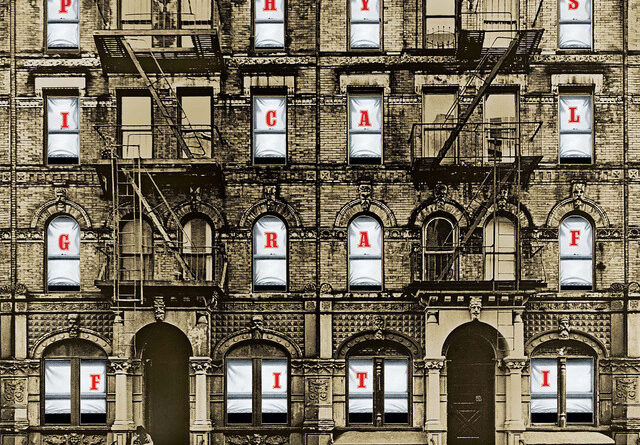HEAVY MUSIC HISTORY: Physical Graffiti – Led Zeppelin
Formed in London at the tail end of the 1960s and needing no formal introduction, LED ZEPPELIN are undisputed titans of British music. They have left a phenomenal legacy on the global music scene, combining the skills of talented session musicians Jimmy Page (guitar, producer) and John Paul Jones (bass, keyboards) with the raw, West Midlands grit of John Bonham (drums) and Robert Plant (vocals, harmonica), the unleashed a brand of music that was brash, ballsy and bombastic yet it was also classy, poetic and emotive. This is captured perfectly in their illustrious back catalogue but none more so than on the band’s sixth album and first independent release on their own label Swan Song Records – Physical Graffiti.
Fifty years on, Physical Graffiti is still just as visceral and awe inspiring as it was on the day of its US release on 24th February 1975. However, like all classic albums, its creation wasn’t going to be smooth sailing. The first attempts to record Physical Graffiti took place in November 1973, where the band took up residence in Hampshire, at Headley Grange – a former Georgian era workhouse. In an interview for Mojo Magazine in 2010, Page stated:
“The reason we went there in the first place was to have a live-in situation where you’re writing and really living the music. We’d never really had that experience before as a group, apart from when Robert and I had gone to Bron-Yr-Aur. But that was just me and Robert going down there and hanging out in the bosom of Wales and enjoying it. This was different. It was all of us really concentrating in a concentrated environment and the essence of what happened there manifested itself across three album”
The band do have a history with this rundown and eerie workhouse however, as they had previously recorded their untitled fourth album – Led Zeppelin IV (1971) as it is known today – at the venue, alongside parts of Led Zeppelin III (1970) and Houses of the Holy (1973). It was during this initial attempt in 1973 that the foundations for Kashmir were laid down by Page and Bonham. Recording was halted when Jones declared to the band’s infamous manager Peter Grant that he had become disillusioned with the group, tired of touring and was considering leaving the band. Grant, in his probably not-so-subtle way, told Jones to reconsider and take the rest of the year off. The studio time was then given to BAD COMPANY, who used it to record songs for their debut self-titled album.
In the January and February of 1974 the band reconvened at Headley and recorded eight tracks with American producer and engineer Ron Nevison (THE WHO, THIN LIZZY, OZZY OSBOURNE, MEATLOAF and more). In Dave Lewis’s 1990 book Led Zeppelin: A Celebration, Plant described these eight tracks as “the belters,” including “off-the-wall stuff that turned out really nice.” There was a notably laid-back and informal atmosphere for these recording sessions, which allowed the band to experiment, improve and come up with alternative arrangements for songs. The leading force behind it was Bonham, who as a result, was given lead songwriter credits on several songs.
The eight tracks were had a run time that was longer than a conventional album, so the band decided to make Physical Graffiti a double album. To the eight new songs, the added unreleased material from other album recording sessions, as a result so little was left over from the recording sessions that there isn’t much that hasn’t been released. Some examples are; an early arrangement of Custard Pie, was reworked as Hots on For Nowhere on the following album, Presence (1976). A number of other outtakes from earlier album sessions that had not been released on Physical Graffiti were included on 1982’s Coda.
Upon the album’s release in 1975, it was commercially and critically a success. Debuting straight in at number one in the album charts in the UK and at number three in the United States. This is partly down to a production delay with the album’s cover sleeve in 1974, which as a result built up a huge advance order. The band prompted the album with a successful US tour as well as a five night residency at Earl’s Court in London – with tickets selling out in just four hours.
NME‘s Nick Kent reviewed the album three months before it was released. He stated “the album’s tonal density is absolutely the toughest, most downright brutal I’ve heard all year” and would later go on to speculate that it was the band’s best work to date. In an Uncut magazine interview, Plant felt that this was the band at their creative peak. The album has had various reissues, remasters and boxed set releases. In 2006 it was certified 16× platinum in the United States by the Recording Industry Association of America (RIAA).
There is no denying that Physical Graffiti has left a lasting impact and legacy on the rock scene as a whole. With millions of streams on Spotify and Apple Music, it is still an album the intensely resonates with people fifty years on, and of course the iconic Kashmir riff is still turning up in all kinds of places from sports events to TV shows. There is truth to Plant’s words that this was the band’s pique, despite the next few albums also reaching number one, this is the album that people will always remember – it is LED ZEPPELIN at their very best.

Physical Graffiti was originally released in the UK on February 28 1975 via Swan Song.
Follow LED ZEPPELIN on Instagram.

